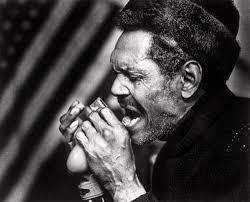Big Walter Horton – A Complete Biography
Introduction
Big Walter “Shakey” Horton, born Walter Horton, stands among the most expressive and technically gifted blues harmonica players of the twentieth century. Known for his huge, bell-like tone and lyrical phrasing, he helped define the amplified Chicago-blues harp sound. Horton was born near Horn Lake, Mississippi, and rose to prominence in Memphis and Chicago as both a respected sideman and an occasional bandleader.

Childhood
Walter Horton was born on April 6, 1921, near Horn Lake, Mississippi, and moved to Memphis as a child. There he began teaching himself the harmonica at the age of five, quickly gaining attention for his natural skill. Horton learned from local masters, including members of the Memphis Jug Band, and spent his childhood playing for tips in Memphis’s Handy Park. He lived with nystagmus, a condition that caused his eyes to move involuntarily, earning him the nickname “Shakey.” Horton left school in the first grade, focusing on his music and earning a reputation as a child prodigy on the harmonica.
Youth
During his teenage years, Horton became a familiar face on the Memphis blues scene, performing with artists such as Johnny Shines, Floyd Jones, and Little Buddy Doyle. His first recordings were made in 1939 with Doyle, showcasing his impressive harmonica work. The 1940s were a challenging period marked by health issues and a series of day jobs, but Horton continued to play music on the streets and in clubs, developing his amplified harmonica style that would later become his trademark.
Adulthood
In 1951, Horton began recording with Sam Phillips in Memphis, releasing tracks under names like “Mumbles” and later “Shakey” or “Big Walter.” By 1953, he had joined Muddy Waters’s band and quickly became a highly sought-after session player. Horton contributed to numerous landmark blues recordings, working with legends such as Otis Rush, Koko Taylor, Jimmy Rogers, and Johnny Shines. Despite his immense talent, he remained a humble sideman, often performing on Chicago’s Maxwell Street even as he toured internationally. Horton recorded several acclaimed albums, gaining recognition among both peers and blues enthusiasts, and became a mentor to younger harmonica players, including Carey Bell.
Major Compositions (Signature Recordings & Performances)
While Horton was primarily celebrated as an interpreter and accompanist rather than a songwriter, he left behind a core discography that highlights his artistry:
- “Easy”: One of his most famous instrumentals, demonstrating his tone and mastery.
- Albums: The Soul of Blues Harmonica (1964), Big Walter Horton with Carey Bell (1972), and Fine Cuts (1977) stand out as essential recordings.
- Sideman Contributions: Horton’s solos on tracks like Jimmy Rogers’s “Walking by Myself” and Otis Rush’s “I Can’t Quit You Baby” remain iconic moments in blues history.
Death
Walter Horton passed away in Chicago on December 8, 1981, at the age of 60. The cause of death was heart failure, complicated by years of heavy drinking. His passing marked the loss of one of blues music’s greatest harmonica voices, and he was posthumously inducted into the Blues Hall of Fame in 1982.
Conclusion
Big Walter Horton was a quiet and reserved man, yet his harmonica spoke volumes. He had a unique ability to blend power and subtlety, inspiring countless musicians who followed. Today, Horton is celebrated as one of the top harmonica players in blues history, his influence extending across generations. Through his recordings and his mentorship of younger artists, his legacy remains deeply woven into the fabric of American blues.

Comments are closed